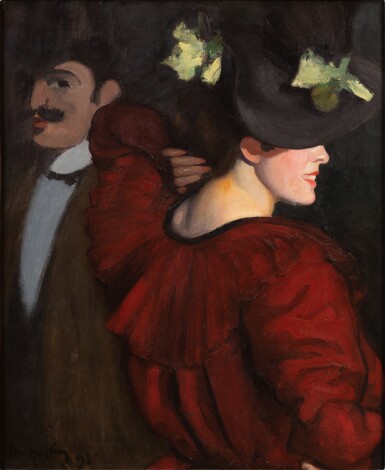
Property from a Private Spanish Collection | Provenant d'une Collection Particulière Espagnole
Louis Anquetin
La Femme à la berthe rouge
Lot Closed
March 25, 02:16 PM GMT
Estimate
80,000 - 120,000 EUR
Lot Details
Description
Property from a Private Spanish Collection
Louis Anquetin
1861 - 1932
La Femme à la berthe rouge
signed Anquetin and dated 91 (lower left)
oil on canvas
73,5 x 60,1 cm; 29 x 23⅝ in.
Painted in 1891.
The authenticity of this work has been confirmed by Galerie Brame & Lorenceau.
__________________________________________________________________________
Provenant d'une Collection Particulière Espagnole
Louis Anquetin
1861 - 1932
La Femme à la berthe rouge
signé Anquetin et daté 91 (en bas à gauche)
huile sur toile
73,5 x 60,1 cm; 29 x 23⅝ in.
Peint en 1891.
L'authenticité de cette œuvre a été confirmée par la Galerie Brame & Lorenceau.
Thibault de la Chatre (acquired at the above sale)
Sale: Christie's, London, June 18, 1993, lot 41
Private collection (acquired at the above sale)
Paris, Le Barc de Boutteville, Troisième Exposition des Peintres Impressionnistes et Synthétistes, 1892-93
Paris, Galerie Brame & Lorenceau, Anquetin: La Passion d'être Peintre, 1991, no. 20, illustrated in the catalogue p. 57 (titled Dans la rue)
"Each painting is a privileged moment, a high point, in the gradual conquest of plastic expression. […] For Anquetin, each painting is a new experience, a decisive stage, a moment of eternity where he concentrates all his capacities to express an idea. This attitude gives his work an exceptional strength. (...)" (Galerie Brame & Lorenceau, Anquetin: La Passion d'être Peintre (exhibition catalogue), Paris, 1991, p. 10)
Lively and expressive lined. Immersive sensoriality. Vigour and efficiency of the touch, of the colour, of the light. This is how Louis Anquetin's work is expressed. From his broad brushstrokes, two close-up figures emerge from the black vaporous mist. Like a photographer, Anquetin captures this fleeting encounter. The man, with a saucy look, directs his attention to the beautiful stranger, highlighted by the only source of light. Concealed by her large headdress, she nevertheless draws attention to her neck and her smile. Does the fiery freedom of the brushstroke evoke the characters moral?
In any case, this spontaneous gesture gives this painting its energy and power. Through his mastery of oil painting, Anquetin emphasizes his volumes and endows his figures with a rare materiality. The canvas mattness, obtained with a blotter to absorb the shine of the medium, reinforces the dimensionality of the composition.
The year 1891 marks a period of experimentation in Anquetin's career. Leaving behind his cloisonnist attempts, the painter gradually frees his forms from their black frame lines and instead lets the colour shape the volumes. In the early 1890s, his palette darkened and then softened, more suitable for the depiction of socialites.
--------------------------------------------------------------------------------------------------------
"Chaque peinture est un moment privilégié, un temps fort, dans la conquête graduelle de l’expression plastique. […] Pour Anquetin, chaque tableau est une nouvelle expérience, une étape décisive, un instant d’éternité où il concentre toutes ses capacités pour exprimer une idée. Cette attitude donne à son œuvre une force exceptionnelle. (…)" (Galerie Brame & Lorenceau, Anquetin: La Passion d'être Peintre (catalogue d’exposition), Paris, 1991, p. 10)
Tracé vif et expressif. Sensorialité immersive. Vigueur et efficacité de la touche, de la couleur, de la lumière. Ainsi s’exprime l’œuvre de Louis Anquetin. De ses larges coups de pinceaux, émergent deux figures du brouillard noir vaporeux. Anquetin capture cette rencontre fugace dans un cadrage resserré, presque photographique. L’homme, au regard grivois, dirige son attention vers la belle inconnue, éclairée par l’unique source de lumière. Dissimulée par sa grande coiffe, elle attire par son geste, l’attention sur sa nuque et son sourire. La liberté fougueuse de la touche renvoie-t-elle aux mœurs de ces personnages ?
La facture spontanée procure en tout cas son énergie et sa puissance à cette toile. Par sa maîtrise de la peinture à l’huile, Anquetin dote ses figures d’une rare matérialité. La matité de la toile, obtenue grâce à l’utilisation d’un buvard pour absorber la brillance du medium, renforce la dimensionnalité de la composition.
L'année 1891 marque une période de transition dans la carrière d’Anquetin. Délaissant ses essais cloisonnistes, le peintre libère peu à peu ses formes de leurs cernes noires pour permettre à la couleur de modeler les volumes. Au début des années 1890, sa palette s’obscurcie avant de se radoucir, plus propice à la représentation de la société mondaine.
You May Also Like







